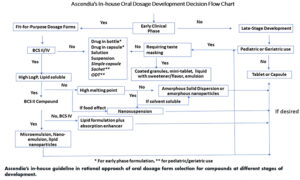Issue:April 2022
FORMULATION FORUM - Oral Formulation Approaches for Different Stages of Clinical Studies
INTRODUCTION
While we observe a rapid increase in new biological approvals in recent years, oral dosage forms still constitute a large percentage in terms of quantity. In fact, oral dosage products accounted for 45% (24 out of 53) of the new drugs approved by the FDA in 2020.
There are two main approaches to formulation development of oral dosage forms for human clinical studies, namely the fit-for-purpose, early phase formulation development and the late-stage commercial formulation development. For many biotech companies, it is the utmost important task to prove the principle in human for their new compounds as soon as possible, thus early phase formulation development has been using “the simple formulation approach” that demands a shorter development timeline, such as solution, suspension, drug in bottle, drug in capsule, liquid-filled capsule, powder for reconstitution, etc. However, in terms of compounds with solubility and bioavailability challenges, how to incorporate “enabling technologies,” such as nanoparticles, amorphous dispersions, and nano-emulsions, into those “simple formulations” remains a challenging task for early phase development. Whereas the late-stage commercial formulation approach typically utilizes QBD principles and DOE experiments to develop a robust clinical formulation that is suitable for use as a commercial product, such as tablet, capsule, liquid-filled capsule, etc. Similarly, incorporation of advanced technologies into regular tablets/capsules dosage forms is a daunting task for late-stage development.
Even though it will be an ideal situation that a formulation can be used for both early phase and the late-stage clinical development and NDA registration, development for a market-image formulation is not initiated until Phase 2b for most of the clinical projects due to the fact that budgets and timelines are tight, and there is pressure to minimize development costs before proof of concept in human.
QUALITY TARGET PRODUCT PROFILES
It is critical to understand the compound’s properties, indication, route of administration, disease model, patient population, and dose range, and to develop a phase-appropriate formulation that can meet QTTP and CQA criteria, including clinical requirements on the systemic exposure and PK profiles, label claim, content uniformity, dissolution, and stability, etc.
Per the ICH Harmonized Tripartite Guideline: Q8(R2) Pharmaceutical Development. August 2009, the quality target product profile (QTPP) is “a prospective summary of the quality characteristics of a drug product that ideally will be achieved to ensure the desired quality, taking into account safety and efficacy of the drug product.” The QTPP is an essential element of a QbD approach and forms the basis of design of the pharmaceutical products. QTPP typically includes the elements such as dosage form, route of administration, dosage strength, and pharmacokinetics to ensure efficacy, safety, and stability, etc.
A critical quality attribute (CQA) is “a physical, chemical, biological, or microbiological property or characteristic that should be within an appropriate limit, range, or distribution to ensure the desired product quality.” The identification of a CQA from the QTPP is based on the severity of harm to a patient should the product fall outside the acceptable range for that attribute. All quality attributes are target elements of the drug product and should be achieved through a good quality management system as well as appropriate formulation and process design and development. CQA for oral dosage forms typically includes identification, assay, content uniformity, dissolution, degradation products, residual solvents, water content, microbial limits, and container closure system.
CONSIDERATIONS FOR EARLY PHASE DEVELOPMENT
The main goal for early phase development is to test the compound safety and efficacy for the intended therapeutic indications in animals and humans. Tremendous efforts have been placed in improving the pharmacokinetic properties of compounds and ensuring bioavailability in animal models and human Phase 1 and 2 studies. Even though a simple formulation, such as solution/ suspension, drug-in-capsule, is always desirable to allow for a fast transition to tox and human studies, a desired compound systemic exposure in testing subjects is a prerequisite to meet the goals of early development. Therefore, time and resources might have to be allocated for compounds with poor bioavailability to achieve a simple elegant dosage form that incorporates sophisticated formulation technologies. Otherwise, the drug program could be at a higher risk of costly failure in first-in-man and at the late stages.
Depending on compound permeability, body clearance half-life, GI absorption in the GI tract, dose, pH solubility, therapeutic window, and bioavailability, different types of dosage forms can be selected for development with the aid of modeling and simulation. When designing a clinical dosage form, ease of administration, dose accuracy, and swallowability should be always considered for the target patient populations. For example, pediatric and geriatric populations may demand liquid dosage forms with taste-masking properties, orally disintegrating tablets, or multi-particulate dosage forms, such as coated beads and powders for reconstitution, that help with ease of swallowing and accurate dosing.
DOSAGE FORM OPTIONS FOR EARLY PHASE CLINICAL STUDY
Drug-in-Bottle
API compound is supplied in a bottle for constitution into solution or suspension. The reconstitution is done at a hospital pharmacy. Commercial vehicles or their modified forms, such as “Ora-Sweet,” could be considered for such purpose. The dose can be further diluted into filled bottles for different doses and for patients to take home. Dose flexibility is the advantage of the approach, and stability requirement is minimum. This dosage form is suitable for in-hospital dosing. In some cases, bulk amorphous solid dispersion formulations can be supplied in bottle and reconstituted by this approach.
Drug-in-Capsule
If the compound is readily wetted and dissolvable in GI fluids without the help of excipients, drug-in-capsule can be considered. Active compound is filled in hard capsules. Drug-in-capsule is suitable for out-patient dosing and for studies requiring blinding.
Solution or Suspension
If the compound is not suspendable or dissolvable in a commonly used suspending vehicle but is stable for a longer time period of at least 3 to 6 months, a formulated solution, suspension, and nanosuspension filled in bottle at a CDMO can be considered. This dosage form is desirable for out-patient dosing. In some cases, lipidic formulation (SEDDS or Nanoemulsions) can be formulated and filled into bottles or hard capsules (as liquid-filled capsule) by this approach.
Formulated Capsule & Tablet
For chronic dosing or a clinical program that is planned to fast progress to late-stage phase, formulated capsules or tablets may be desired. API compound can be simply blended with a diluting excipient, and the blend is filled in hard capsules, or in some cases, for API that has challenges in flowability, wettability, and dosage uniformity, a formulated capsule or tablet may be considered. For poorly water-soluble compounds, it is possible that the enabling formulations, such as nanosuspensions, lipidic formulations, and amorphous solid dispersions, can be further incorporated into the capsule and tablet dosage forms. Particularly, liquid-filled capsules that contain lipidic formulations have been used for both early and late-stage development.
CONSIDERATION FOR LATE-STAGE FORMULATION DEVELOPMENT
Oral formulation development normally goes through the following steps: 1) Definition of the quality target product profile (QTPP) and CQA; 2) Assessment of drug physical-chemical and biopharmaceutical properties that are relevant to oral dosage form design and that impact on CQA; 3) Modeling and simulation to define the dose and the simulated drug-absorption PK profiles; 4) selection of an appropriate formulation technology and in vitro test methods to evaluate formulations in vitro; 5) Identification of critical formulation variables that impact drug dissolution, bioavailability, and formulation stability; 6) In vivo study in animal or human models using prototype formulations for selection of a lead formulation; 7) Development of in vitro/in vivo relationship (IVIVR) or correlation (IVIVC) to aid product development; 8) Using QBD principle, conduct DOE experiments to identify critical process parameters; and 9) Scale up and manufacture for late-stage studies.
Oral dosage forms for late-stage and commercial production are preferably manufactured using conventional high-speed manufacturing processes. Traditional manufacturing processes for oral dosage forms include homogenizer for suspension, blending, roller compaction, comil for dry granulation, wet granulation by high shear granulator or fluid bed, drying by oven or fluid bed, milling, lubrication, encapsulation, capsule banding, tablet compression and coating, etc. To achieve a robust formulation and manufacturing procedure, it is important to understand the critical processing parameters (CPPs) that impact critical quality attributes (CQA). For tablet or capsule development, as a part of QBD, API properties (particle size, shape, crystallinity, solubility, drug loading, or flowability) that could potentially impact on the content uniformity, dissolution, compression, stability, and bioavailability should be evaluated together with critical process parameters (CPP), such as granulation volume/time, blending speed and time, impeller and chopper speed, lubrication time, drying time/temperature, and compression force and speed.

For compounds with solubility and bioavailability issues, the overall design and development process for late-stage dosage forms can be divided into the following steps: (1) to enhance the solubilities and dissolution rates using an enabling technology; and (2) to incorporate the drug intermediate with enhanced solubility in a traditional oral dosage form. Additional QBD and CPP should also be evaluated on the intermediate manufacturing process. For example, for nanosuspensions, the factors or combined factors such as milling speed, milling temperature, milling bead size, ratio of milling bead to formulation, drug concentration, milling time, etc., should be evaluated. For spray drying process, atomization pressure, spray rate, product temperature, solid content in spray solution, drug to polymer ratio, air volume, etc., are important to the formation of amorphous solid dispersion, particle size, dissolution, achievement of supersaturation, residual solvent level, yield, and product stability.
For formulation optimization, a DOE using factorial design may utilize 2-3 levels of critical excipients and their combination to evaluate their impact on CQA, such as dissolution, granule flowability, disintegration, hardness, etc. An optimum level of the formulation composition, such as drug loading, API particle size, filler, binder, disintegrant, glidant, and lubricant of a tablet formulation, can be determined from the DOE experiment. For the process optimization, once risk assessment is done in selection of CPPs and CQAs, DOE experiments using factorial design may select a few process parameters with three levels in combination with API of different particle size to evaluate their effects on granule flowability, compression, hardness, disintegration, and dissolution. Based on the statistical analysis, a design space will be identified to define the control strategy for large-scale manufacturing.
SUMMARY
Oral dosage forms still constitute a large percentage in term of quantity. It is of the utmost important task to utilize a phase-appropriate formulation development approach for early development and later-stage commercial development. Early phase formulation development has been using “the simple formulation approach,” which, however, sometimes may require incorporating sophisticated technology for compounds with challenging properties in solubility and bioavailability, whereas late-stage development demands utilization of QBD principle and DOE experiment to optimize formulation and process parameters in order to achieve a robust commercial-viable formulation.

Jim Huang, PhD
Founder & CEO
Ascendia Pharmaceuticals
j.huang@ascendiapharma.com
www.ascendiapharma.com
Total Page Views: 10486











